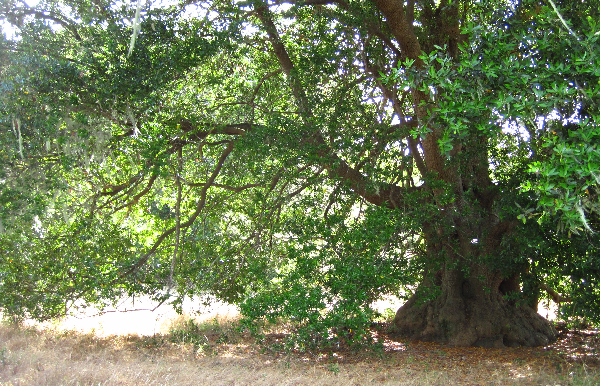- Data Basin |
- Use Cases |
- MC2 Dynamic Global Vegetation Model
MC2 Dynamic Global Vegetation Model

Explore related items…
Simulating changes in vegetation cover, carbon and nitrogen cycling, water budget as well as projecting fire occurrence and effects
The dynamic global vegetation model MC (version) 2 (Bachelet et al. 2015a and b, Creutzburg et al. 2015, Sheehan et al. 2015, Turner et al. 2015), the C++ version of MC (version) 1 (Bachelet et al., 2015), simulates vegetation type, plant growth and associated biogeochemical cycles, as well as their response to natural wildfires. MC2 consists of a more efficient version of MC1, better suited to run on a supercomputer to simulate large domains at fine scales. The model structure and algorithms of MC1 were conserved.
The model simulates the dynamics of lifeforms rather than species, including evergreen and deciduous needleleaf and broadleaf woody lifeforms (trees and shrubs), C3 and C4 herbaceous lifeforms (grasses, forbs and sedges) as they respond to both climate change and increasing atmospheric CO2 concentration. It simulates competition between woody and herbaceous lifeforms for light, nitrogen and available soil water.
The model simulates net primary production and monthly values of live and dead plant compartment pools from which it derives the size of the various fuel types. Using litter characteristics it simulates decomposition, soil respiration and nutrient release over time. Nitrogen inputs are calculated as in the original CENTURY model (Parton et al. 1994) to include release from organic matter turnover, wet/dry deposition, and biological nitrogen fixation. The model also estimates the height, trunk diameter and bark thickness of average-sized trees from live aboveground woody biomass using lifeform-specific allometric relationships. Based on this information and climate indices, it calculates fire occurrence and effects including mortality (without consumption) and fire emissions (Lenihan et al. 2008). It modifies carbon stocks after a fire accordingly, thereby allowing for the simulation of a post-fire "succession".
Code updates have been documented with versions maintained on a stable server (https://sites.google.com/site/mc1dgvmusers/home/mc2).
Inputs: Model inputs include soil characteristics (mineral depth, texture, bulk density), annual atmospheric CO2 concentrations, and monthly climate (minimum and maximum temperature, precipitation, and vapor pressure).
Run protocol: MC2, like MC1, is run in four distinct successive phases: first, an equilibrium phase where potential vegetation cover is generated using average historical climate (often 1895-1924) and fire return intervals are fixed. Carbon pools are initialized for each potential vegetation type until the resistant soil carbon reaches stability (less than 1% change per year), which may last up to 3000 years. During the second or spinup phase, the model uses detrended historical climate data (adjusted to the 1895-1924 mean to avoid an abrupt transition with the historical phase) iteratively for 600 years to readjust the carbon pools and vegetation types in response to dynamic fire simulations. This phase ends when the carbon exchange stabilizes and the net biological production (net ecosystem production - fire losses) nears zero. The third or transient phase is run with transient historical climate data from Daly et al. (2008) starting in 1895 and then with climate futures ending in 2100.
BIBLIOGRAPHY
Bachelet, D., and D. Turner (editors). 2015. Global Vegetation Dynamics: Concepts and Applications in the MC1 Model. AGU Geophysical Monographs 214. 210pp
Bachelet, D., K. Ferschweiler, T.J. Sheehan, B.M. Sleeter and Z. Zhu. 2015. Projected carbon stocks in the conterminous US with land use and variable fire regimes. Global Change Biology 21(12): 4548-4560. DOI: 10.1111/gcb.13048.
Bachelet, D., T. Sheehan, K. Ferschweiler, and J. Strittholt. 2015. Climate change effect on southern California deserts. Journal of Arid Environments 127:17-29.
Creutzburg, M.K., E.B. Henderson, and D.R. Conklin. 2015. Climate change and land management impact rangeland condition and sage-grouse habitat in southeastern Oregon. AIMS Environmental Science 2(2).
Halofsky, J.S., J.E. Halofsky, D.R. Conklin, D. Bachelet, M.A. Hemstrom, B.K. Kerns, and A.T. Morzillo. 2015. Using a dynamic global vegetation model to help inform management decision. Chapter 10. In: D. Bachelet and D. Turner (editors). Global Vegetation Dynamics: Concepts and Applications in the MC1 Model. AGU Geophysical Monographs 214. 210pp
Peterman, W., D. Bachelet, K. Ferschweiler, and T. Sheehan. 2014. Soil depth affects simulated carbon and water in the MC2 dynamic global vegetation model. Ecological Modelling 294:84-93.
Peterman, W. and K. Ferschweiler. 2015. A case study for evaluating potential soil sensitivity in arid land systems. Integrated Environmental Assessment and Management DOI 10.1002/ieam.1691.
Sheehan, T., D. Bachelet, and K. Ferschweiler. 2015. Projected major fire and vegetation changes in Northwest forests of the conterminous United States. Ecological Modelling 317:16-29.
Turner, D.P., D.R. Conklin, and J.P. Bolte. 2015. Impacts of projected climate change on forest land cover and land use in the Willamette River Basin, Oregon. Climatic Change. On line 29 July 2015 - DOI 10.1007/s10584-015-1465-4.
Upcoming:
Bachelet, D., T. Sheehan, K. Ferschweiler, and J. Abatzoglou. 2016 (accepted). Simulating vegetation change, carbon cycling and fire over the western US using CMIP5 climate projections. Chapter X. In: K. Riley (editor). Natural Hazard Uncertainty Assessment. AGU Geophysical Monographs #XXX.
- Citation
- Dominique Bachelet. 2015. MC2 Dynamic Global Vegetation Model. In: Data Basin. [First published in Data Basin on Oct 23, 2015; Last Modified on Aug 5, 2016; Retrieved on Dec 31, 2025] <https://databasin.org/articles/8e01bd5f101c4863a0d6a69d58c9298b/>
About the Author
Dominique received her Master’s degree in 1978 in Lille (France) and her Ph.D. in 1983 from Colorado State University with a thesis focused on biogeochemical cycles in the shortgrass prairie. In 1984 she went to U.C. Riverside as a postdoc simulating nitrogen fixing shrubs in the Sonoran desert then...

